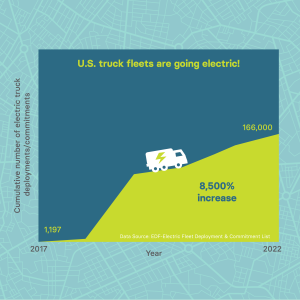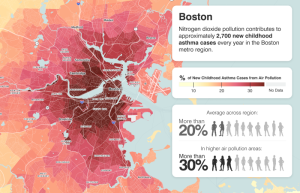The ZEV future is here: An 8,500% increase in truck deployments, commitments is proof.
 Commercial U.S. fleets are going big on electric trucks, according to a new EDF analysis of class 2b-8 fleet announcements, which finds a nearly 8,500% increase in zero-emission fleet deployments and commitments since 2017.
Commercial U.S. fleets are going big on electric trucks, according to a new EDF analysis of class 2b-8 fleet announcements, which finds a nearly 8,500% increase in zero-emission fleet deployments and commitments since 2017.
To arrive at this eye-popping stat, EDF tracked public announcements of leading fleet commitments to deploy zero-emission trucks, as well as actual deployments (trucks on roads).
The recent influx of these vehicles — most of which are electric — is an important step toward reducing the health-harming, climate change pollution from diesel trucks and a key indicator of a flourishing market. But more ambition from policymakers is needed if we are going to achieve 100% zero-emission truck sales by 2035 — a critical date to ensure a near-zero-emission transportation sector by 2050.
What’s behind the growth in zero-emission trucks?
Thanks to the declining upfront cost of zero-emission trucks and their associated fueling infrastructure, increased model availability, improved range, and robust government and utility incentives, commercial and municipal fleets of all sizes and duty cycles are deploying and making commitments to deploy zero-emission trucks. All of this progress is moving zero-emission trucks from the showroom floor to highways and local streets across America.
Market readiness for a ZEV future is here: An 8,500% increase in truck deployments is proof. Share on XEDF’s analysis finds that nearly 200 fleets have made commitments to deploy or have deployed zero-emission trucks — a nearly 1100% increase since 2017. While the bulk of demand is currently coming from large private and public entities, like Amazon and the United States Postal Service, fleets of all sizes are beginning to make the transition from diesel to zero-emission trucks.
While the shift from gas- to diesel-powered trucks took over 40 years to reach 90% sales, the transition from diesel to zero-emission trucks has the potential to happen much quicker based on the technological readiness of and rapid increase in zero-emission trucks. The rate of transition, however, is far behind what’s necessary to mitigate the harmful climate and health impacts of diesel trucks. Under current rates of electrification, only 29% of medium- and heavy-duty vehicles will be zero-emission by 2050, according to BloombergNEF analysis.
Diesel trucks are devastating communities
Medium- and heavy-duty vehicles account for just 5% of vehicles on U.S. roads, but are responsible for nearly a quarter of all climate pollution and nearly half the deaths from air pollution linked to transportation. People of color and those with lower incomes bear this health burden disproportionately. According to the American Lung Association, people of color are more than three and a half times more likely to breathe the most polluted air when compared to white people.
Long-term exposure to dirty truck pollution can have devastating health impacts on the most vulnerable members of our communities. For example, EDF analysis of recent air quality research estimates that on average 1 in 5 cases of new childhood asthma are attributable to pollution in Boston – but in the neighborhoods with the most traffic-related pollution, it can be up to 1 in 3.
Government action is imperative
While the recent growth in fleet commitments and deployments is impressive – and an important indicator of where the truck market is headed – state and federal policymakers need to allocate more resources to ensure rapid, equitable growth. The climate and health imperative we face demands it.
To accelerate this transition and ensure we are maximizing the health, climate and economic benefits of this paradigm shift, policymakers must create:
- Long-term emission standards for medium- and heavy-duty vehicles: To provide market certainty for future investments in zero-emission trucks, state and federal policymakers must establish a pathway to 100% sales of new zero-emission trucks and buses by 2035 and, in the interim, enact policies that curb harmful diesel emissions.
- Clean, affordable charging infrastructure: Complexities around charging still remain a significant barrier to wide-scale EV adoption, and this is especially true for trucks. The recently passed Infrastructure Investment and Jobs Act contains $5 billion for charging infrastructure. States need to leverage this investment and develop infrastructure programs that reflect the unique needs of electric trucks.
- An equity-centered approach to deployment: Deployment of charging stations and zero-emission trucks should be prioritized in low-income, pollution-burdened communities first, where the air quality benefits of zero-emission technologies are needed most.
By rapidly taking these steps, policymakers can build on the exciting momentum we’re seeing in the zero-emission truck market and unleash widespread adoption of these life-saving, climate-protecting trucks.











